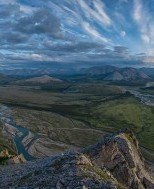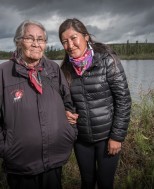First Nations and environmental groups launch legal action to protect Yukon’s Peel River Watershed
Vancouver, BC – Today in Vancouver, Thomas R. Berger, O.C., Q.C. announced that a lawsuit is being filed against the Yukon Government on behalf of two Yukon First Nations and two Yukon environmental organizations.
Berger and his clients, the First Nation of Nacho Nyak Dun, Tr’ondëk Hwëch’in, Canadian Parks and Wilderness Society Yukon Chapter (CPAWS Yukon) and the Yukon Conservation Society are launching a legal action to force the Yukon Government to implement a Land Use Plan that would protect 54,000 square kilometres of wilderness in northern Yukon’s Peel River Watershed, against mining and other industrial development.
“This is a lawsuit that nobody wanted to bring,” said Berger. “But the Yukon Government has forced these plaintiffs to go to court not only in defense of First Nations and environmental values in Yukon, but also to uphold principles entrenched in the Constitution.”
Following a constitutionally mandated process under Yukon land claims agreements and seven years of research and consultation, the Peel Watershed Planning Commission produced a final plan that recommended the permanent protection of 55 per cent and interim protection for an additional 25 per cent of the 67,500 square kilometre Peel River Watershed.
Although the Commission’s plan is supported by the affected First Nations and has wide public support, on January 21, 2014, the Yukon Government adopted its own unilaterally developed plan for the region, which opens up most of the watershed to roads and industrial development. Yukon Government’s plan leaves 71 per cent of the watershed open for mineral staking and industrial development. In the "protected areas" identified by the Yukon Government, which cover just 29 per cent of the watershed, all-season roads would be allowed in order to develop existing mining claims.
“Since 1993, when the Yukon First Nations, Canada and Yukon signed the Umbrella Final Land Claims Agreement, its provisions have formed the basis of land use planning in the Yukon. Those provisions are entrenched in the Constitution; they protect the rights of First Nations and all Yukoners,” said Berger. “Yukon Government’s plan discards the years of work by the Peel Planning Commission as well as the views of Yukoners.”
Nacho Nyak Dun Chief Ed Champion emphasized the opportunities that were available for input during the planning process. “The Government of Yukon had seven years to provide input into the planning process while the Peel Commission was developing its Final Recommended Plan,” Chief Champion said. “Chapter 11 of our Land Claims Agreement does not allow the Government to introduce a new plan at the end of the process. We will do whatever it takes to defend the integrity of our Agreements.”
Tr’ondëk Hwëch’in Chief Eddie Taylor spoke about what the Peel River Watershed means to his people. “As our elders say, the Peel Watershed is our church, our university and our breadbasket. It sustains our spirit, our minds and our bodies. It is as sacred to us as it was to our ancestors, and as it will be to our grandchildren.”
“The fresh water that the seven rivers of the Peel Watershed provide is by far the most valuable resource within the Peel,” Chief Taylor added.
“Seventy-five per cent of the Yukon is open to mineral staking,” said CPAWS Yukon Executive Director Gill Cracknell. “To compensate for the fragmentation and disturbance resulting from industrial development on the rest of the landscape, we need to set aside large areas for wildlife, cultural uses, tourism and climate change adaptation. The Peel region is one of the last remaining ecologically-intact wilderness watersheds left in north America. There needs to be real protection, not postage stamp areas riddled with roads and mines.”
Karen Baltgailis, Executive Director of the Yukon Conservation Society, issued a warning to companies who may be eyeing the Peel now that Yukon Government has announced its land use plan. “Companies considering industrial exploration or development in the Peel region until this lawsuit is resolved do so at their own risk. The tide of public opinion will be against anyone who tries to develop in the region. On the other hand, companies that voluntarily give up their Peel claims in the name of corporate responsibility will win major points in the hearts and minds of people in Yukon and around the world.”
About the Peel River Watershed
Located at the northern end of the Rocky and Mackenzie Mountain Chain, the Peel River Watershed is a spectacularly rugged region defined by the Peel, Ogilvie, Blackstone, Hart, Wind, Snake and Bonnet Plume rivers. One of Canada's most striking and pristine mountain river watersheds, the Peel is the heart of a great mountain ecosystem with a long cultural history, free-ranging wildlife and a rugged northern beauty. Encompassing over 67,500 square kilometres, the Peel Watershed dwarfs more famous landscapes, such as Banff and Yellowstone national parks–in size, unspoiled splendor and ecological integrity.
The Peel Watershed is one of North America's largest intact ecosystems–a region of mountains, deep canyons, plateaus, wetlands and rolling hills laced by rivers. The watershed is the northern anchor of the Yellowstone to Yukon Conservation Initiative, a broad-based international project to protect ecosystem connections for wildlif
Back to all news »






